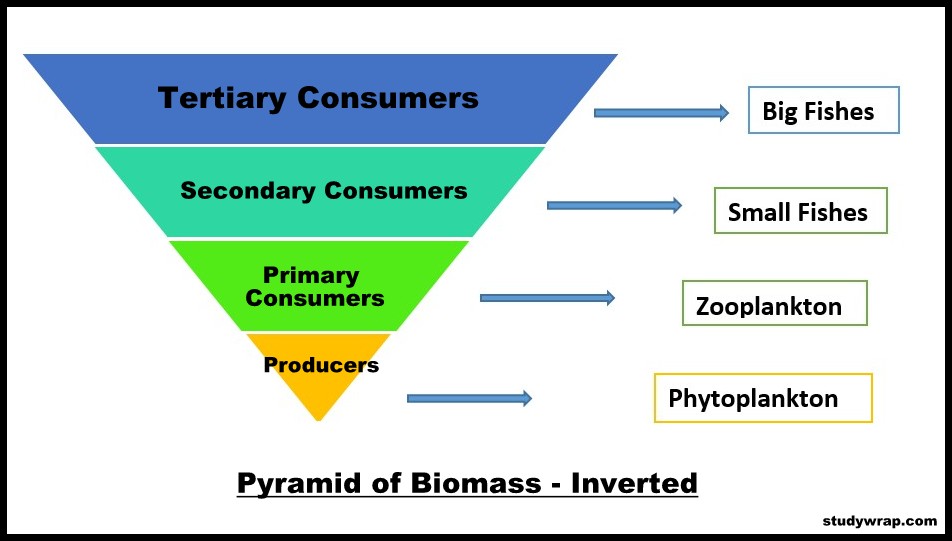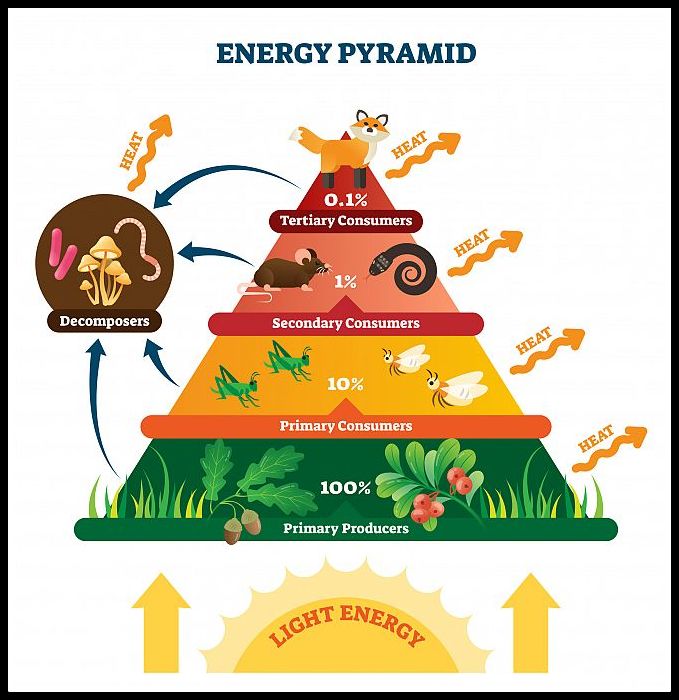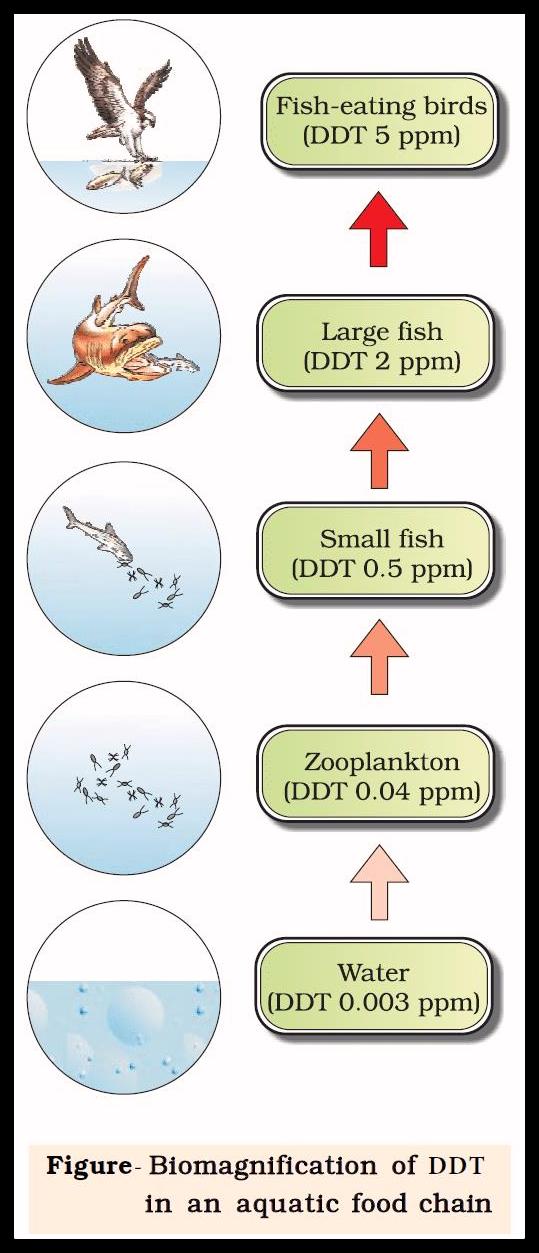Environment
Ecological Pyramids of Number, Biomass and Energy
FUNCTIONS OF ECOSYSTEM
Table of Contents
- The function of an ecosystem is a broad, vast and complete dynamic system. It can be studied under the following three heads.
- Energy flow
- Nutrient cycling (biogeochemical cycles)
- Ecological succession or ecosystem development
ENERGY FLOW
- Energy is the basic force responsible for all metabolic activities.
- The flow of energy from producer to top consumers is called Energy Flow which is unidirectional.
Trophic level interaction
-
- A trophic level is the representation of energy flow in an ecosystem.
- The trophic level of an organism is the position it occupies in a food chain.
- The levels through which food energy passes from one group of organism to the other group are called trophic levels.
- Trophic level interaction deals with how the members of an ecosystem are connected based on nutritional needs.
- Trophic levels are numbered according to the steps an organism is away from the source of food or energy, which is the producer (plants).
- Energy always flows from lower (producer) to higher (herbivore, carnivore etc.) trophic level.
- Energy level decreases from the first trophic level upwards due to loss of energy in the form of heat at each trophic level.
- This energy loss at each trophic level is quite significant. Hence there are usually not more than four-five trophic levels (beyond this the energy available is negligible to support an organism).
-
- The trophic level interaction involves three concepts namely –
- Food Chain
- Food Web
- Ecological Pyramids
- The trophic level interaction involves three concepts namely –
Food Chain and Food Web has been discussed in previous post, to read that post you can Click Here. We will discuss Ecological Pyramids here.
ECOLOGICAL PYRAMIDS
- The pyramidal representation of trophic levels of different organisms based on their ecological position (producer to final consumer) is called as an ecological pyramid.
- The pyramid consists of a number of horizontal bars depicting specific trophic levels. The length of each bar represents the total number of individuals or biomass or energy at each trophic level in an ecosystem.
- The food producer forms the base of the pyramid and the top carnivore forms the tip. Other consumer trophic levels are in between.
- The ecological pyramids are of three categories:
- Pyramid of numbers,
- Pyramid of biomass, and
- Pyramid of energy or productivity.
Pyramid of Numbers
- The relationship between the numbers of primary producers and consumers of different levels. It is a graphic representation of the total number of individuals of different species, belonging to each trophic level in an ecosystem.
- Pyramid of numbers represents the total number of individuals of different species (population) at each trophic level.
- It is very difficult to count all the organisms, in a pyramid of numbers and so the pyramid of number does not completely define the trophic structure for an ecosystem.
- Depending upon the size, the pyramid of numbers may not always be upright, and may even be completely inverted.
Pyramid of numbers – upright
-
-
- In this pyramid, the number of individuals is decreased from lower level to higher trophic level.
- This type of pyramid can be seen in the grassland ecosystem and pond ecosystem.
-
-
-
- The grasses occupy the lowest trophic level (base) because of their abundance.
- The next higher trophic level is primary consumer – herbivores like a grasshopper.
- The individual number of grasshoppers is less than that of grass.
- The next energy level is a primary carnivore like rats.
- The number of rats is less than grasshoppers, because, they feed on grasshoppers.
- The next higher trophic level is secondary carnivore like snakes. They feed on rats.
- The next higher trophic level is the top carnivore like Hawk.
- With each higher trophic level, the number of individual decreases.
-
Pyramid of numbers – inverted
-
-
- In this pyramid, the number of individuals is increased from lower level to higher trophic level. E.g. Tree ecosystem.
-
-
-
- A count in a forest would have a small number of large producers, for e.g. few number of big trees.
- This is because the tree (primary producer) being few in number and would represent the base of the pyramid and the dependent herbivores (Example – Birds) in the next higher trophic level and it is followed by parasites in the next trophic level. Hyper parasites being at higher trophic level represents higher in number.
-
Pyramid of Biomass
- Biomass pyramid includes the total weight of the organic matter (total biomass) of each trophic level. Thus, the pyramid formed by total biomass at each trophic level is called biomass pyramid.
- This overcomes the size difference problem because all kinds of organisms at a trophic level are weighed.
- Each trophic level has a certain mass of living material at a particular time called the standing crop.
- The standing crop is measured as the mass of living organisms (biomass) or the number in a unit area. Biomass is measured in g/m2.
Pyramid of Biomass – upright
-
-
- For most ecosystems on land, the pyramid of biomass has a large base of primary producers with a smaller trophic level rested on top.
-
-
-
- The biomass of producers (autotrophs) is at the maximum. The biomass of next trophic level i.e. primary consumers is less than the producers. The biomass of next higher trophic level i.e. secondary consumers is less than the primary consumers. The top, high trophic level has very less amount of biomass.
-
Pyramid of Biomass – Inverted
-
-
- In many aquatic ecosystems, the pyramid of biomass may assume an inverted form. (In contrast, a pyramid of numbers for the aquatic ecosystem is upright)
-
-
-
- This is because the producers are tiny phytoplankton that grows and reproduces rapidly.
- Here, the pyramid of biomass has a small base, with the consumer biomass at any instant exceeding the producer biomass and the pyramid assumes an inverted shape.
-
Pyramid of Energy
- To compare the functional roles of the trophic levels in an ecosystem, an energy pyramid is most suitable.
- An energy pyramid represents the amount of energy at each trophic level and loss of energy at each transfer to another trophic level. Hence the pyramid is always upward, with a large energy base at the bottom.
- Suppose an ecosystem receives 1000 calories of light energy in a given day. Most of the energy is not absorbed; some is reflected to space; of the energy absorbed only a small portion is utilized by green plants, out of which the plant uses up some for respiration and of the 1000 calories; therefore only 100 calories are stored as energy-rich materials.
- Now suppose an animal, say a deer, eats the plant containing 100 calories of food energy. The deer use some of it for its metabolism and stores only 10 calories as food energy. A lion that eats the deer gets an even smaller amount of energy. Thus, usable energy decreases from sunlight to producer to herbivore to carnivore. Therefore, the energy pyramid will always be upright.
- Energy pyramid concept helps to explain the phenomenon of biological magnification– the tendency for toxic substances to increase in concentration progressively with higher trophic levels.
Ecological Efficiency
-
-
- Ecological efficiency describes the efficiency with which energy is transferred from one trophic level to the next.
- The number of trophic levels in the grazing food chain is restricted as the transfer of energy follows 10 % law – only 10 % of the energy is transferred to each trophic level from the lower trophic level.
- The decreases at each subsequent trophic level is due to two reasons:
- At each trophic, a part of the available energy is lost in respiration or used up in metabolism.
- A part of the energy is lost at each transformation.
-
Limitations of Ecological Pyramids
-
- It does not consider the same species belonging to two or more trophic levels.
- Ecological Pyramids assumes a simple food chain, something that seldom exists in nature; it does not accommodate a food web.
- Moreover, saprophytes (plant, fungus, or microorganism that lives on decaying matter) are not given any place in ecological pyramids even though they play a vital role in the ecosystem.
PRODUCTIVITY
- In ecosystems the rate of production of organic matter is known as productivity.
- Primary productivity refers to production at the autotroph level, and secondary productivity refers to production at the heterotroph level.
- Productivity can be further divided into gross and net.
- Gross productivity is the total amount of organic matter produced, and net productivity is the amount of organic matter left after some has been used in respiration.
- Primary gross productivity will depend on the efficiency of photosynthesis and the amount of light energy coming into the system. The intensity and duration of sunlight varies globally so that the potential for gross primary productivity will vary greatly with different ecosystems.
- Secondary productivity will depend on the conversion of plant substances to animal substances. The efficiency of transfer of energy from one trophic level to the next is known as ecological efficiency.
- Primary productivity depends on the plant species inhabiting a particular area. It also depends on a variety of environmental factors, availability of nutrients and photosynthetic capacity of plants. Therefore, it varies in different types of ecosystems.
Pollutants and Trophic Level
- Pollutants move through the various trophic levels in an ecosystem.
- Non-degradable pollutants (persistent pollutants), which cannot be broken down by detrivores, not only move through the various trophic levels but also remain in that tropic level for a very long duration.
- Chlorinated Hydrocarbons (Organochlorides) are the most damaging non-degradable pollutants that are long-lasting.
- Movement of these pollutants involves two main processes –
-
- Bioaccumulation
- Biomagnification
-
Bioaccumulation
- Bioaccumulation is the gradual accumulation of pollutants, chemicals (chronic poisoning) or other substances in an organism.
- Bioaccumulation occurs when the rate of loss of the substance from the body of the organism through catabolism (breakdown of complex molecules in living organisms), or excretion is lower than the rate of accumulation of the substance.
- As persistent organic pollutants like DDT are long-lasting, the risk of bioaccumulation is high even if the environmental levels of the pollutant are not high.
Biomagnification
- Biomagnification, also known as bioamplification, is the process by which substances become more concentrated in the bodies of consumers as one moves up the food chain (trophic levels).
- In order for biomagnification to occur, the pollutant must have a long biological half-life (long-lived), must not be soluble in water but must be soluble in fats. E.g. DDT.
- If the pollutant is soluble in water, it will be excreted by the organism.
- Pollutants that dissolve in fats are retained for a long time. Hence it is traditional to measure the amount of pollutants in fatty tissues of organisms such as fish.
- Following substances have the potential to biomagnify:
-
- Polychlorinated Biphenyls used as insulators in transformers and fire retardants.
- Polynuclear aromatic hydrocarbons which are present in petroleum products.
- Heavy metals like Mercury, copper, cadmium, chromium, lead, nickel, zinc, tin (TBT or tributyltin).
- Cyanides used in fishing and gold leaching.
-
Effects of biomagnification
-
-
- High concentrations of DDT in some bird species caused failure of eggs by thinning the shells.
- PCBs can affect the immune system, fertility, child development and possibly increase the risk of certain cancers.
- Mercury poisoning interferes with the nervous system development in foetuses and young children.
-
Bioaccumulation v/s Biomagnification
- Although sometimes used interchangeably with bioaccumulation, an important distinction between the bioaccumulation and biomagnification is that bioaccumulation occurs within a trophic level, and is the increase in concentration of a substance in certain tissues (usually in fatty tissue.) of organisms’ bodies due to absorption from food and the tissues of organisms representing four successive trophic levels in a food chain.
So, this was all about Ecological Pyramids of Number, Biomass and Energy – Function of Ecosystem.
In the Next Post (Click Here), we will learn about various Biogeochemical Cycles.







